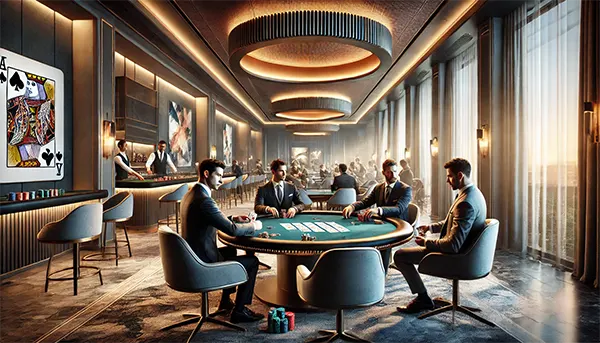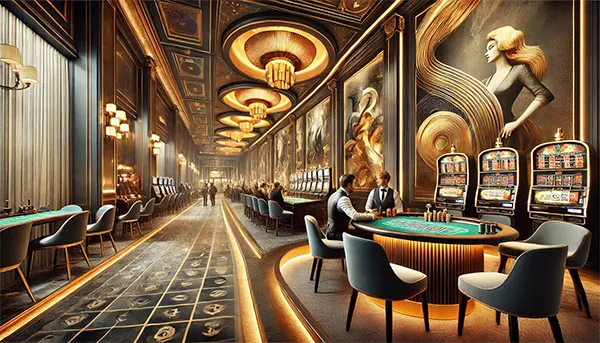
Casino Imagery in Postmodern Art
The casino, as a symbol of risk, randomness, and fate, has become an important element in postmodern art. From painting to cinema and digital art, this imagery is used to reflect social inequality, the gamble of life, and the philosophy of chance. The modern understanding of a casino goes beyond mere gambling establishments—it embodies an entire cultural and psychological phenomenon. Through various artistic mediums, creators explore the human fascination with luck, the illusion of control, and the consequences of risk-taking.
Postmodern art often deconstructs traditional representations, and the casino is no exception. Artists use its imagery to critique capitalism, human obsession with chance, and the fine line between entertainment and self-destruction. The flashing lights, hypnotic sounds, and extravagant interiors of casinos create an environment that can be interpreted as both exhilarating and isolating. This duality has inspired many artists to incorporate casino motifs in their work, whether through visual distortions, allegorical storytelling, or digital reinterpretations.
Casinos in Painting: From Symbolism to Pop Art
Painting in the 20th and 21st centuries has actively used casino imagery to convey themes of illusionary control, temptation, and extravagance. From classical symbolists to contemporary pop-art painters, the casino represents deeper social and psychological aspects. This subject matter has been particularly appealing to artists who explore human emotions tied to greed, addiction, and fate.
The early 20th century saw the rise of paintings that depicted gambling dens, card players, and decadent casino interiors. These works often reflected the tension between chance and skill, between fortune and loss. Later, as the pop-art movement emerged, artists began using bright colours, exaggerated forms, and commercial aesthetics to portray the casino as a playground of mass consumption and entertainment.
Postmodern Approaches to Depicting Casinos
For example, the works of Edward Hopper, while not always directly depicting casinos, convey a sense of isolation characteristic of those engrossed in gambling. His use of light and shadow evokes a feeling of detachment, highlighting the loneliness often masked by the glamour of casinos. Meanwhile, modern artists such as Richard Prince experiment with poker imagery and slot machines, merging them with pop-cultural references to comment on consumerism and addiction.
Some contemporary painters integrate digital elements into their artworks, mimicking the flashing lights and repetitive patterns of slot machines. These stylistic choices emphasize the sensory overload that casinos create, illustrating how gambling environments manipulate human perception and decision-making. This approach allows artists to blend the real and the artificial, questioning the authenticity of experience in a world dominated by spectacle.
Casinos in Cinema: From Glamorous Myth to Harsh Reality
Casino films have created a unique aesthetic that combines luxury, tension, and fatalism. From classics like Martin Scorsese’s “Casino” (1995) to arthouse films such as “Uncut Gems” (2019), casino imagery helps explore social inequality and the psychology of risk-taking. These films often highlight the allure of wealth and power while simultaneously exposing the dark side of the gambling industry.
In Hollywood, casinos have long been portrayed as places of high stakes and drama. Whether through heist films, gangster stories, or character-driven dramas, the visual language of casino movies frequently revolves around bright neon lights, opulent interiors, and tables filled with cash. However, beyond the glamour, these films often reveal the destructive consequences of greed and excess.
Key Cinematic Techniques
The camera often focuses on players’ gestures, the movement of the roulette ball, or the flashing neon signs to convey the atmosphere of suspense and unpredictability. The use of close-ups and fast-paced editing creates an immersive gaming experience. Directors frequently employ slow-motion shots to intensify key moments, such as a high-stakes bet or the final spin of a roulette wheel.
Lighting plays a crucial role in casino films. While luxurious chandeliers and golden reflections may dominate the foreground, shadows often lurk in the background, symbolizing hidden dangers. Additionally, sound design contributes to the immersive experience—ringing slot machines, shuffling cards, and murmured conversations help create a sensory-rich environment that mimics the real-world casino atmosphere.
Many filmmakers use the contrast between casino exteriors and interiors to reinforce thematic messages. The bright, alluring façade of a casino may represent opportunity and excitement, while the back rooms and underground dealings highlight corruption and despair. This juxtaposition allows for a more nuanced portrayal of gambling culture, emphasizing both its appeal and its perils.

Digital Art and Casinos: New Forms of Expression
In the modern era, casinos have become a theme in digital art, including NFTs, video installations, and VR projects. This allows artists to explore the concepts of randomness, simulation, and human interaction with digital environments. As technology advances, the depiction of gambling has evolved beyond traditional media, offering new ways to engage with casino imagery.
Digital artists use coding, artificial intelligence, and blockchain technology to create artworks that respond to chance in real-time. Some projects generate unique visual pieces based on randomized algorithms, mimicking the unpredictability of gambling outcomes. This approach raises questions about the nature of luck, control, and artistic creation itself.
Interactivity and New Technologies
Some artists create algorithmic projects where winnings or losses depend on random numbers generated in blockchain systems. This further emphasizes how casinos symbolize the interaction between human choice and technology. By incorporating AI-driven elements, these artworks challenge traditional notions of authorship and artistic intention.
Virtual reality has also played a role in reshaping casino imagery. Some installations allow viewers to experience the thrill of a high-stakes poker game or the solitude of an empty casino floor through VR simulations. These immersive experiences enable audiences to step into the world of gambling from new perspectives, reinforcing the emotional and psychological impact of casino culture.
Overall, the casino in postmodern art is more than just entertainment. It serves as a metaphor for societal processes, power relations, and the randomness of human existence. Whether through traditional paintings, cinematic storytelling, or interactive digital experiences, the representation of casinos in art continues to evolve, reflecting humanity’s ongoing fascination with risk and reward.
